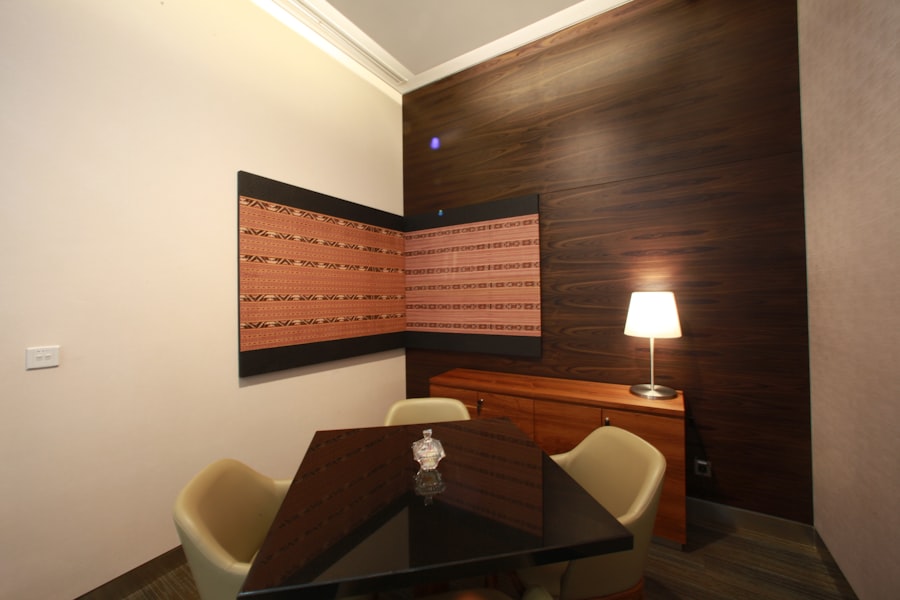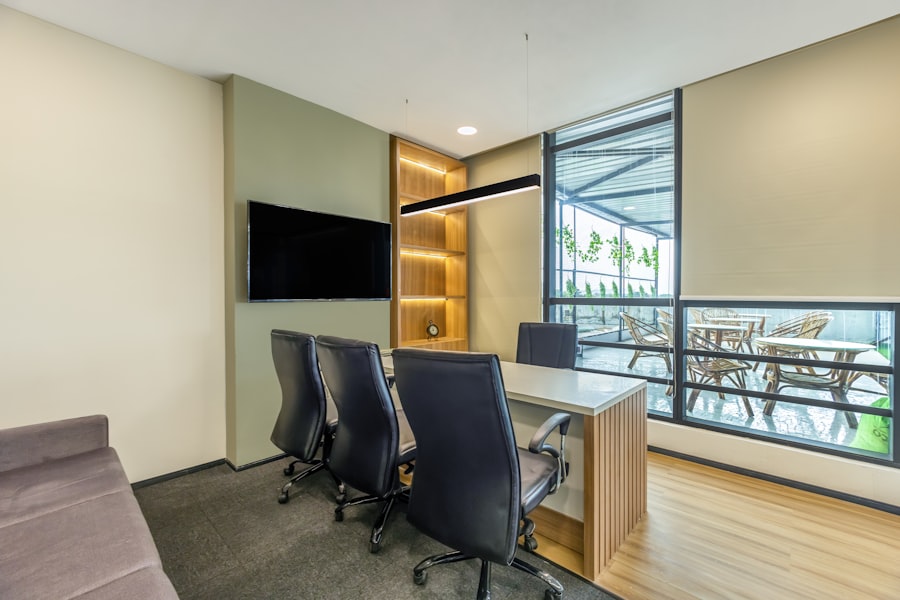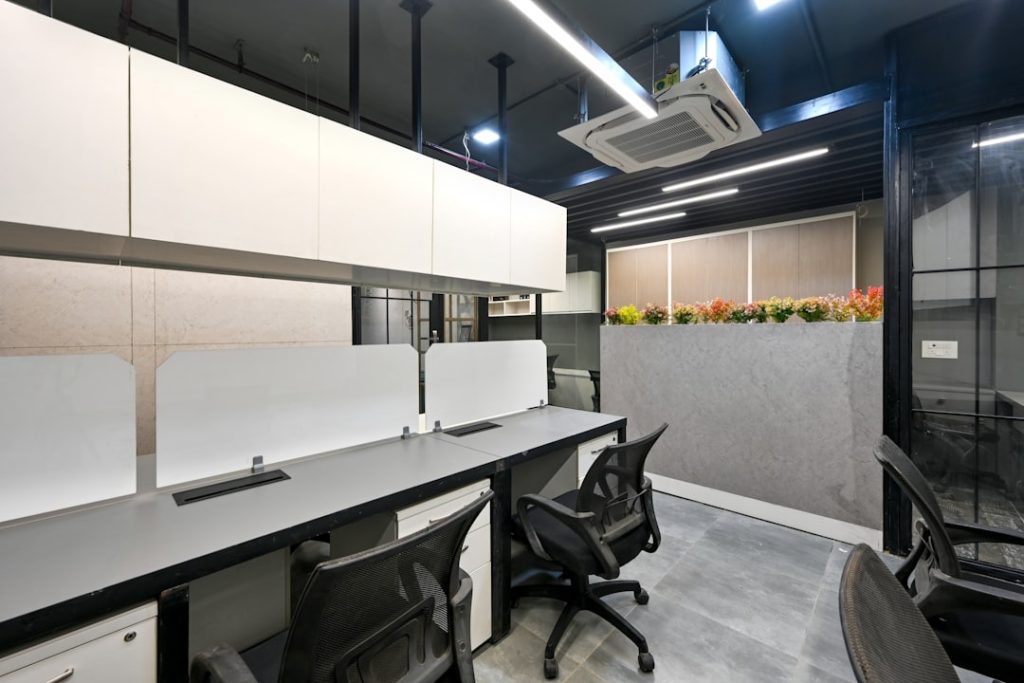Built-in cabinets have become an essential feature in modern home offices, offering a blend of functionality and aesthetic appeal. One of the primary benefits of these cabinets is their ability to maximize space. Unlike freestanding furniture, built-in cabinets can be designed to fit snugly into the contours of a room, utilizing every inch effectively.
This is particularly advantageous in smaller home offices where space is at a premium. By integrating storage solutions directly into the architecture of the room, homeowners can create a more organized and efficient workspace that minimizes clutter and enhances productivity. In addition to space efficiency, built-in cabinets provide a seamless look that can elevate the overall design of a home office.
They can be customized to match the existing decor, whether it be contemporary, traditional, or eclectic. This customization allows homeowners to create a cohesive aesthetic that reflects their personal style while also serving practical purposes. Furthermore, built-in cabinets can be designed with specific features such as adjustable shelving, pull-out drawers, and hidden compartments, making them versatile enough to accommodate various office supplies and equipment.
The result is a workspace that not only looks polished but also functions optimally for daily tasks.
Key Takeaways
- Built-in cabinets enhance home office organization, storage, and aesthetics.
- Thoughtful design and customization optimize functionality and space utilization.
- Integrating technology and wiring ensures a clean, efficient workspace.
- Selecting appropriate materials and finishes contributes to durability and style.
- Professional installation guarantees quality and maximizes the benefits of built-in cabinets.
Design Considerations for Home Office Built-In Cabinets
When designing built-in cabinets for a home office, several key considerations must be taken into account to ensure that they meet both aesthetic and functional needs. First and foremost is the layout of the office space. The placement of windows, doors, and existing furniture will influence where the cabinets can be installed.
For instance, if a room has a large window that provides natural light, it may be beneficial to position the desk near this light source while ensuring that the built-in cabinets do not obstruct the view. Additionally, the flow of movement within the space should be considered; cabinets should not impede access to other areas of the office. Another important design consideration is the style and finish of the cabinets.
Homeowners should think about how the cabinets will complement other elements in the room, such as wall colors, flooring, and decorative accents. For example, if the office features dark wood flooring and light-colored walls, opting for built-in cabinets in a medium wood tone can create a balanced look. Furthermore, hardware choices—such as knobs and handles—should align with the overall design theme.
Whether opting for sleek modern finishes or more traditional hardware, these details can significantly impact the final appearance of the built-in cabinetry.
Customizing Built-In Cabinets to Maximize Storage and Functionality

Customization is one of the standout features of built-in cabinets, allowing homeowners to tailor their storage solutions to their specific needs. One effective way to maximize storage is by incorporating various types of shelving. Adjustable shelves can accommodate items of different heights, from books to binders to decorative objects.
Additionally, including specialized compartments for technology—such as cable management systems or dedicated spaces for printers—can enhance functionality and keep the workspace organized. Another customization option is the inclusion of multi-purpose features within the built-in cabinets. For instance, a fold-out desk or a pull-out work surface can provide additional workspace when needed while remaining hidden when not in use.
This flexibility is particularly useful in smaller home offices where every square foot counts. Furthermore, integrating lighting within the cabinets can improve visibility and create an inviting atmosphere. LED strip lights or spotlights can illuminate shelves and work areas, making it easier to find items and enhancing the overall ambiance of the office.
Incorporating Technology and Wiring into Built-In Cabinets
| Metric | Description | Typical Value | Notes |
|---|---|---|---|
| Power Outlet Count | Number of electrical outlets integrated per cabinet | 2-4 | Depends on device requirements and cabinet size |
| Data Port Count | Number of Ethernet or data ports installed | 1-3 | Supports wired internet or network connections |
| Wire Gauge | Standard wire thickness used for power wiring | 14-16 AWG | Ensures safety and adequate current capacity |
| Conduit Diameter | Size of conduit used for wiring protection | 3/4 inch | Allows easy pulling of multiple cables |
| Ventilation Openings | Number of vents or fans installed for heat dissipation | 1-2 vents or 1 small fan | Prevents overheating of electronic devices |
| Maximum Load Capacity | Maximum electrical load supported by cabinet wiring | 15-20 amps | Based on circuit breaker and wiring specs |
| Cable Management Features | Types of cable organizers included | Velcro straps, cable clips, raceways | Improves organization and accessibility |
| Installation Time | Average time to wire and install technology in one cabinet | 4-6 hours | Varies with complexity and cabinet size |
In today’s digital age, technology plays a crucial role in home offices, making it essential to consider how to incorporate wiring and tech solutions into built-in cabinets effectively. One approach is to design cabinets with built-in cable management systems that conceal unsightly cords and wires. This not only creates a cleaner look but also reduces the risk of tripping hazards and makes it easier to keep surfaces tidy.
For example, grommets can be installed in desk surfaces or cabinet tops to allow cables to pass through discreetly. Moreover, homeowners may want to consider integrating charging stations within their built-in cabinets. This could involve installing outlets inside drawers or on shelves where devices like laptops, tablets, and smartphones can be charged without cluttering the workspace with cords.
Additionally, smart technology can be incorporated into built-in cabinetry; for instance, touch-activated lighting or automated shelving systems can enhance convenience and modernize the office environment. By thoughtfully planning for technology integration, built-in cabinets can become not just storage solutions but also hubs for productivity.
Choosing the Right Materials and Finishes for Home Office Built-In Cabinets
The choice of materials and finishes for built-in cabinets significantly impacts both their durability and aesthetic appeal. Common materials include plywood, MDF (medium-density fiberboard), and solid wood, each offering distinct advantages. Plywood is often favored for its strength and resistance to warping, making it suitable for larger cabinet structures.
MDF provides a smooth surface ideal for painting or veneering, allowing for versatile design options at a lower cost than solid wood. Solid wood, while typically more expensive, offers unmatched durability and a timeless look that can enhance property value. Finishes also play a critical role in determining the final appearance of built-in cabinets.
Homeowners should consider whether they prefer painted finishes for a modern look or stained finishes that highlight natural wood grain. Additionally, matte versus glossy finishes can create different visual effects; matte finishes tend to offer a more subdued elegance while glossy finishes can add a contemporary flair. It’s also important to select finishes that are easy to clean and maintain, especially in a workspace where spills or dust accumulation may occur frequently.
Maximizing Space with Multi-Functional Built-In Cabinets

Multi-functional built-in cabinets are an excellent solution for maximizing space in home offices, particularly in environments where every square inch counts. These cabinets can serve multiple purposes beyond mere storage; for instance, they can incorporate desks that fold away when not in use or include seating areas with cushions that double as storage boxes. This versatility allows homeowners to adapt their workspace according to their needs throughout the day.
In addition to foldable desks and hidden seating, built-in cabinets can also feature modular components that allow for reconfiguration as needs change over time. For example, stackable shelves or movable dividers can help create customized spaces for different tasks—whether it’s organizing paperwork or displaying decorative items. By investing in multi-functional cabinetry, homeowners not only optimize their available space but also create an adaptable environment that evolves with their work habits.
Tips for Organizing and Decluttering with Built-In Cabinets
Built-in cabinets are invaluable tools for organizing and decluttering home offices effectively. To make the most of these storage solutions, homeowners should start by categorizing items based on their usage frequency. Frequently used items should be easily accessible—perhaps stored in lower drawers or on open shelves—while less frequently used items can be placed higher up or in deeper compartments.
This strategic organization ensures that essential tools are within reach while maintaining an orderly appearance. Another effective tip is to utilize clear bins or labeled containers within built-in cabinets to further enhance organization. These containers help keep similar items together and make it easy to locate specific supplies without rummaging through cluttered drawers.
Additionally, incorporating vertical dividers within drawers can help separate documents or files by category, preventing them from becoming mixed up over time. Regularly reassessing what items are stored in these cabinets will also aid in decluttering; removing unnecessary items ensures that only what is truly needed remains accessible.
Hiring a Professional for Home Office Built-In Cabinet Installation
While DIY projects can be rewarding, hiring a professional for built-in cabinet installation often yields superior results in terms of quality and craftsmanship. Professionals bring expertise in design and construction that ensures cabinets are not only aesthetically pleasing but also structurally sound and functional. They can provide valuable insights into material selection, layout optimization, and design trends that may not be apparent to those without experience in cabinetry.
Moreover, professional installers have access to specialized tools and techniques that facilitate precise measurements and installations. This attention to detail minimizes the risk of errors that could lead to costly adjustments later on. Additionally, many professionals offer warranties on their work, providing peace of mind that any issues arising post-installation will be addressed promptly.
Ultimately, investing in professional installation can save time and stress while ensuring that built-in cabinets enhance both the functionality and beauty of a home office space.



